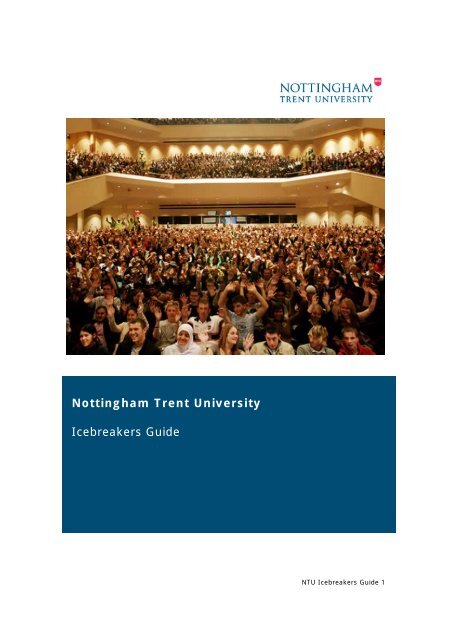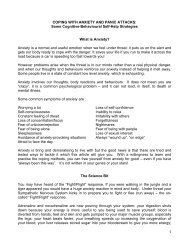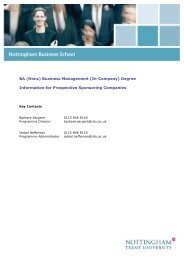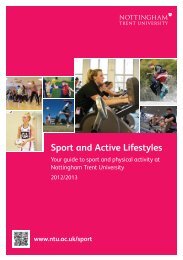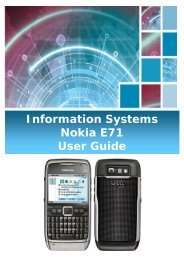Nottingham Trent University Icebreakers Guide
Nottingham Trent University Icebreakers Guide
Nottingham Trent University Icebreakers Guide
Create successful ePaper yourself
Turn your PDF publications into a flip-book with our unique Google optimized e-Paper software.
<strong>Nottingham</strong> <strong>Trent</strong> <strong>University</strong><br />
<strong>Icebreakers</strong> <strong>Guide</strong><br />
NTU <strong>Icebreakers</strong> <strong>Guide</strong> 1
NTU <strong>Icebreakers</strong> <strong>Guide</strong><br />
Dear Colleague<br />
Please find attached a guide to 24 different icebreakers to facilitate with your<br />
students. They are divided into two sections and intended to give you another tool<br />
for your teaching toolkit/ arrow for your quiver (please insert your own metaphor).<br />
The sections are<br />
• Getting to Know You<br />
• These are usually short exercises intended to help students say one another’s<br />
names out loud and find out a little about one another. These are useful near<br />
the very start of an induction programme when students are perhaps a little<br />
reluctant to speak to one another.<br />
• Team Challenges<br />
• These exercises are slightly different and are intended to encourage students<br />
to work with one another on a task. The tasks are usually physical in nature<br />
giving an easy point to focus on.<br />
Some issues about using icebreakers<br />
An ice-breaker is a short activity designed to encourage participants to talk to one<br />
another and to share some limited information about themselves. Ice-breakers can<br />
be as simple as asking students to turn to one another and introduce themselves to<br />
the people sat next to them, or they can be complex lengthy activities where<br />
students can find a lot out about each other. Ideally there ought to be a fun aspect<br />
to the activities in order to provide participants with some shared history that they<br />
can discuss later and, where possible, a relevance to the taught course/ university<br />
experience.<br />
Why are they useful?<br />
For some students, finding themselves in a year group with up to 250 other students<br />
is not a problem; they’ll have already started to make friends in their hall/ house, in<br />
the Union of Students, or in bars, pubs and nightclubs around <strong>Nottingham</strong>. For<br />
many though, it’s a frightening challenge.<br />
“I felt isolated and the unhappiest I have ever felt.” - Interview with a student who<br />
withdrew from their degree course (Ozga & Sukhnandan pg 34 (2001))<br />
Ice-breakers are a gentle way of ensuring that ALL students start to talk to one<br />
another and find out the names of the people they will be studying with.<br />
Research in the School of Art & Design during the 2003 – 2004 academic year<br />
identified what students wanted from their induction to the <strong>University</strong>. The three<br />
main factors were:<br />
1. Will I make any friends?<br />
NTU <strong>Icebreakers</strong> <strong>Guide</strong> 2
2. Who will I be working with?<br />
3. Who will I be living with?<br />
Ice-breakers are one of the tools teaching staff can use to help students to answer<br />
the first two questions. It would be overstating the case to claim that ice-breakers<br />
are all that is required to enable students to develop friendships, but they are one<br />
technique teaching staff can use to engender an environment in which such<br />
friendships can blossom.<br />
When are ice-breakers useful?<br />
<strong>Icebreakers</strong> are potentially at their most useful with groups of students coming<br />
together for the first time. The most obvious use is during the Welcome Week, but<br />
there are also benefits in facilitating ice-breakers at the start of subsequent years<br />
and at the start of group projects. A minority of students won’t have learnt the<br />
names of their peers by the end of the first year; perhaps because it is embarrassing<br />
to ask other students their names once the initial induction window has closed. The<br />
occasional use of ice-breakers throughout the year may help such students to feel<br />
less isolated from their peers.<br />
Tips for facilitating ice-breakers<br />
“I’m sorry, but it says here that we’ve got to do an ice-breaker now.”<br />
Ice-breakers are relatively-active, energetic activities. Lecturers need to congruently<br />
communicate this in the way they facilitate the activity. If you hate the idea of doing<br />
ice-breakers, then it’s probably worth swapping this particular task with a colleague.<br />
Programme teams should try to ensure that they are using a range of different<br />
icebreakers with their student groups. Even the best icebreaker starts to grate if<br />
overused. There are twenty four ice-breakers in this guide and an internet search<br />
will quickly turn up hundreds of activities for use.<br />
Try to link the ice-breakers into the course. This does not necessarily mean<br />
cataloguing the learning outcomes for each activity, but if the relevance of the icebreakers<br />
can be introduced to the group, and links made to future learning, students<br />
are likely to engage more fully.<br />
Rehearse the ice-breaker. Most of the ice-breakers are extremely easy to facilitate,<br />
being essentially structured discussions, however some are more complex and these<br />
will require some preparation. If you would like to discuss how each ice-breaker<br />
works, please feel free to contact Ed Foster, ext 88203<br />
Health & Safety<br />
There is an element of risk with some of these activities (there’s marginally more<br />
activity than asking students to sit at their desks), but it’s very minimal. You’ll need<br />
to look at the instructions and think through any issues raised. Please don’t hesitate<br />
to contact Ed Foster if you have any concerns.<br />
NTU <strong>Icebreakers</strong> <strong>Guide</strong> 3
Complete List of <strong>Icebreakers</strong><br />
1. Juggling Balls<br />
2. Line Outs<br />
3. Stripper<br />
4. Human Bingo<br />
5. Three of a kind<br />
6. Corners<br />
7. 2 truths, 1 lie<br />
8. Coat of arms<br />
8. Coat of arms<br />
9. Trauma, trivia, joy<br />
10. Most tenuous claim to fame<br />
11. Balloons<br />
12. Paper Aeroplanes<br />
13. Postcards<br />
14. Group Map<br />
15. The M&M Game<br />
15. The M&M Game<br />
17. Lego Tower<br />
18. Paper Tower<br />
19. Keyboard<br />
20. Toxic Waste<br />
21. Newspaper Fashion<br />
22. Trust Levitation<br />
23. Shepherd<br />
24. Egg Drop<br />
NTU <strong>Icebreakers</strong> <strong>Guide</strong> 4
Getting to<br />
Know You<br />
NTU <strong>Icebreakers</strong> <strong>Guide</strong> 5
1. Juggling Balls<br />
Time – 5 – 10 mins Suggested max. participants – 25 – 30<br />
Equipment required – 3 juggling balls (£ couple from ToysR’us), name badges<br />
Activity level – Participants will be throwing & catching, and need to be able speak<br />
and hear one another’s names<br />
Explanation<br />
This ice-breaker generates a lot of energy and usually plenty of laughs.<br />
Get the participants into a circle, ask them to write out / put on name badges.<br />
Explain that they will be passing the juggling ball around the group by making eye<br />
contact with another person calling their name and then throwing the ball to them.<br />
(You might want to emphasise underarm only.<br />
Pass the ball around the group from one person to the next and ask each person to<br />
say their name aloud and one fact about themselves.<br />
When the ball comes back to you, pick someone out, make eye contact, call their<br />
name, then throw them the juggling ball.<br />
Once they start to get the hang of it introduce the second juggling ball and then the<br />
third. As facilitator watch to make sure that everyone gets a go.<br />
Variations & Your Notes<br />
Team challenge variation. (You need a watch/ timer)<br />
Once they have tried it out and got used to the exercise, collect the ball and explain<br />
that this time you are going to set them a challenge. Each person in the group will<br />
catch the ball from one person, then throw it to another so that everyone in the<br />
circle will have touched the ball once. (You throw to Pete, who throws to Jane, who<br />
throws to Sunita, who throws to Lucy, until the ball comes back to you)<br />
Tell the group to remember the order and explain that they are going to do it again<br />
in the same order and you are going to time it. Time it once, then give them the<br />
chance to go faster. People tend to get very fired up at the chance to shave a few<br />
seconds off their time.<br />
Stripper Variation<br />
Do the Stripper ice-breaker and then give the group the chance to do this exercise<br />
using their stripper names.<br />
NTU <strong>Icebreakers</strong> <strong>Guide</strong> 6
2. Line Outs<br />
Time – 10 mins Suggested max. participants – 25 – 30<br />
Equipment required – none<br />
Activity level – People will need to be able to move around and sort themselves<br />
into a line<br />
Explanation<br />
The group will form themselves into a continuous line based upon criteria you set.<br />
Examples include<br />
First name – Andrew to Zoë<br />
Height – Shortest to tallest<br />
Shoe size – Smallest to largest<br />
Birthday (probably best not to use age)<br />
Hand size<br />
Zodiac Signs<br />
The furthest they’ve ever travelled<br />
Variations & Your Notes<br />
Ask the group to do the exercise without speaking<br />
Ask the group to do it stood on chairs – be very careful about checking the chairs are<br />
okay and talking to the group about taking care.<br />
If you use the shortest to tallest line out, it is possible to go get the group to sit on<br />
one another’s knees. (Too complex to explain, email ed.foster@ntu.ac.uk for<br />
details.)<br />
NTU <strong>Icebreakers</strong> <strong>Guide</strong> 7
3 Stripper<br />
Time – 5 - 10 mins Suggested max. participants – 20 (gets a bit boring with<br />
many more names (consider breaking the group into 2 smaller<br />
teams if any larger than this)<br />
Equipment required – OHP/ flipchart<br />
Activity level – Very limited, people need to arrange themselves into a circle<br />
Explanation<br />
Explain to the group that this exercise may prove useful should their academic<br />
career not work out the way they expected. This exercise will work out what their<br />
stage name might be should they ever choose to take up the career of being a<br />
stripper. (I’m not sure if Careers have any relevant information)<br />
The formula is very simple<br />
Your first name – name of your first ever pet<br />
Your surname – your Mum’s maiden name<br />
Give the group a moment or two to work it out and then ask each participant to<br />
explain their name in turn<br />
Obviously this has some potential to offend, I’ve never found this to be the case, but<br />
you might want to use this once you know the group<br />
Variations & Your Notes<br />
Juggling Balls<br />
Works well if you then use some juggling balls and have the group do the juggling<br />
balls icebreaker using their stripper names. This might be a good activity for second<br />
year groups who already know one another.<br />
Pen Name<br />
Essentially the same exercise, but usually a little less embarrassing<br />
First name – your middle name<br />
Surname – the first ever street you lived on<br />
NTU <strong>Icebreakers</strong> <strong>Guide</strong> 8
4. Human Bingo<br />
Time – 20 mins Suggested participants – 20 - 150<br />
Equipment required – A copy of the Human Bingo grid per participant (SEE<br />
APPENDIX 1) and one on acetate, participants need pens. A prize would be excellent<br />
Activity level – People will be walking around talking to one another<br />
Explanation<br />
Hand out the Human Bingo Grid to everyone in the group. On the handout are 20<br />
boxes; in each of the boxes is a heading. They must speak to other people in the<br />
room, find someone who meets the heading for each box. For example, one of the<br />
headings is “Left Handed” they must find someone in the room who is left handed<br />
and write their name in the box. NB it must be a different person for every box.<br />
Some of the boxes have an asterisk, in these instances the person must actually<br />
demonstrate that they can do what is asked for. For example “Roll their tongue”<br />
the person must actually roll their tongue.<br />
The first person back to the front with all their boxes filled in is the winner. Read out<br />
the headings and check that the answers are genuine. With large groups have prizes<br />
for second and third place to keep the exercise going a little longer.<br />
The grid is located in appendix 1<br />
Variations & Your Notes<br />
NTU <strong>Icebreakers</strong> <strong>Guide</strong> 9
5. Three of a kind<br />
Time – 10 mins Suggested max. participants – 10 + (works better with<br />
larger groups)<br />
Equipment required – participants will need pen and paper, two prizes<br />
Activity level – participants will need to be able to move around and talk to one<br />
another<br />
Explanation<br />
Explain to the group that they must find three different people in the room that they<br />
share something in common. These factors must not be:<br />
Something visible – e.g. both men, both have heads<br />
Connected to their programme<br />
Connected to living in <strong>Nottingham</strong><br />
The first person back to the front with all three things written down wins a prize.<br />
Give one out for the most outlandish/ freaky thing that two people have in common.<br />
Variations & Your Notes<br />
NTU <strong>Icebreakers</strong> <strong>Guide</strong> 10
6. Corners<br />
Time – 10 - 30 Suggested max. participants – 25 – 30<br />
mins<br />
Equipment required – OHP/ Flipchart, Signs with Agree Strongly, Agree, Disagree,<br />
Disagree Strongly written on<br />
Activity level – participants must be able to move around to the corners of the<br />
room<br />
Explanation<br />
This is a potentially contentious and challenging icebreaker, manage it carefully. The<br />
basic idea is for the facilitator to read out a series of contentious statements and for<br />
the group to arrange themselves into four corners of the room based upon how they<br />
feel about the issue. The corners will be either:<br />
Agree Strongly<br />
Agree<br />
Disagree<br />
Disagree Strongly<br />
Once into their corner, the group must come up with 2 reasons why they feel as they<br />
do about the particular issue. Each group has the chance to then explain their<br />
reasoning and invite others to join them, give people the chance to change their<br />
minds if one group puts forward a particularly good argument.<br />
Possible issues include<br />
All drugs should be legalised<br />
Euthanasia is wrong<br />
Designer babies are a good thing<br />
The UK should have a policy of zero immigration<br />
The Death Penalty should be reinstated for murder<br />
The War on terror is just<br />
Britain should join the Euro<br />
UK foreign policy is racist<br />
As graduates earn considerably more than non-graduates, tuition fees should be<br />
doubled<br />
Multi-culturalism is a bad thing<br />
Clearly, there is the potential for this exercise to alienate some people. I would<br />
recommend starting it with some discussion about respecting one another’s points of<br />
view.<br />
Variations & Your Notes<br />
Have only two options – agree and disagree<br />
NTU <strong>Icebreakers</strong> <strong>Guide</strong> 11
7. 2 truths, 1 lie<br />
Time – 10 – 20 Suggested max. participants – 10 +<br />
mins<br />
Equipment required – participants require pen and paper<br />
Activity level – people will be sitting working in groups of 6 - 8<br />
Explanation<br />
Split the group into syndicate teams of 6 – 8.<br />
Each person must write down three statements about themselves; two of them are<br />
true, one is a lie.<br />
Each person then reads out their statements and the group has to work out which<br />
are true and which are lies. The group may ask one question.<br />
This exercise would work well with students who already know one another.<br />
Variations & Your Notes<br />
NTU <strong>Icebreakers</strong> <strong>Guide</strong> 12
8. Coat of arms<br />
Time – 30 mins Suggested max. participants – up to 30<br />
Equipment required – flipchart pens, flipchart paper, blue tac<br />
Activity level – Participants will need space to draw and wall space to hang their<br />
masterpieces on<br />
Explanation<br />
Each participant gets a sheet of flipchart paper and a flipchart pen. They are going<br />
to create their own unique coat of arms. They need to write their name at the top of<br />
the paper, draw a shield, divide it into quarters and leave space for a motto<br />
underneath<br />
In each quarter they will need to draw something that represents them:<br />
1. Personal Achievement<br />
2. Family<br />
3. Interests/ hobbies<br />
4. Personal ambition<br />
They will also need to devise a personal motto, (use of Latin is optional)<br />
Put all the flipchart sheets up on the wall and turn the room into an art gallery. Give<br />
people a few minutes to look at what other people have drawn.<br />
Variations & Your Notes<br />
If coats of arms are a little militaristic, participants could devise pub signs, or simply<br />
divide the page into 4.<br />
This might be a good idea to use before starting to discuss progress files.<br />
NTU <strong>Icebreakers</strong> <strong>Guide</strong> 13
9. Trauma, trivia, joy<br />
Time – 15 mins Suggested participants – multiples of groups of 8<br />
Equipment required – none<br />
Activity level – People will be sitting in groups of about 8 talking to one another<br />
Explanation<br />
Split the group into syndicate teams of approximately 8.<br />
Each person must think about:<br />
One trauma in their life right now (an anxiety, rather than a deep personal issue)<br />
One joy in their life at the moment<br />
One piece of trivia that they have come across recently (Big Brother gossip,<br />
pointless science, football fact etc)<br />
Variations & Your Notes<br />
NTU <strong>Icebreakers</strong> <strong>Guide</strong> 14
10. Most tenuous claim to fame<br />
Time – 15 mins Suggested max. participants – multiples of groups of 8<br />
Equipment required – perhaps some prizes<br />
Activity level – Participants will sit in groups talking to one another<br />
Explanation<br />
It would be interesting to see how much the supposed celeb-rification of our society<br />
has reached the students. Get the group to discuss any links to famous people that<br />
they have. Each subgroup must choose the most tenuous link to someone famous,<br />
i.e. there is a link to a genuinely famous person, but it’s frankly rubbish, or the<br />
famous person is definitely a C list celebrity.<br />
Let each group explain their links to the rich and famous. The whole group then<br />
votes on the most tenuous claim to fame, i.e. there is a link to a genuinely famous<br />
person, but it’s frankly rubbish, or the famous person is definitely a C list celebrity.<br />
So if one of the participants plays 5-a-side with David Beckham all well and good,<br />
but if a participant’s cousin once went out with a girl who’s brother once played 5-aside<br />
with David Beckham, all the better. To give you an example, I once managed a<br />
student whose boyfriend went to school with the man who played Darth Maul in Star<br />
Wars: the Phantom Menace.<br />
Variations & Your Notes<br />
NTU <strong>Icebreakers</strong> <strong>Guide</strong> 15
11. Balloons<br />
Time – 30 mins +<br />
(depends on group<br />
size)<br />
Suggested max. participants – multiples of groups of 8,<br />
needs at least 20, will work with very large groups<br />
Equipment required – 1 balloon per person, paper & pens, flipchart paper & pens<br />
Activity level – Participants will inflate balloons, throw them around the room, catch<br />
them and then work in small groups<br />
Explanation<br />
Give each participant a post card sized piece of paper, and ask them to write down<br />
one anxiety that they have about starting at <strong>University</strong>. On the other side ask them<br />
to write one thing that they are looking forwards to.<br />
Hand out the balloons. Ask the students to put their paper into the balloons then<br />
inflate and tie them. Now get everyone together in the middle of the room, throw<br />
the balloons into the air, waft them about for a few moments and then have the<br />
participants catch the balloons.<br />
Split the participants into teams of 8. They then burst the balloons and read the<br />
comments people have made about what they are looking forward to. Then working<br />
in groups they explore ways of dealing with the anxieties that students have written<br />
down.<br />
Feedback solutions at the end, perhaps offering additional reassurance and support<br />
as you do so.<br />
Variations & Your Notes<br />
NTU <strong>Icebreakers</strong> <strong>Guide</strong> 16
12. Paper Aeroplanes<br />
Time – 20 mins Suggested participants – 20 +<br />
Equipment required – Paper Aeroplane templates, lots of different coloured paper<br />
Activity level – Participants will make paper aeroplanes, throw them into the air,<br />
catch a plane and then work in pairs<br />
Explanation<br />
This exercise is a good way of randomly pairing up participants; it works well with<br />
very large groups. People will throw and then catch a paper aeroplane and then find<br />
the other person in the group with the matching plane. The planes will have<br />
different animals on them: elephants, zebras, cats etc. You will need to photocopy<br />
the planes onto different coloured paper and make sure that you have two of each.<br />
For example the two participants who catch the blue aeroplane with an elephant on it<br />
sit down together, so will the pair who catch the green penguins, etc.<br />
Therefore, make sure that you produce enough pairs of coloured aeroplanes for all<br />
the participants in your group. As they enter the venue, give everyone a paper<br />
aeroplane. Ask them to follow the instructions, fold the plane and when everyone is<br />
ready all the planes are thrown into the air and caught. Participants will need to find<br />
the other person that caught the same plane as themselves, then sit down and<br />
answer the questions on the plane.<br />
Written on the plane are some instructions:<br />
Please find out about the person you are sat with.<br />
• Where do they come from and why did they choose <strong>Nottingham</strong> <strong>Trent</strong>?<br />
• What have they enjoyed most so far about being at <strong>University</strong>?<br />
• What are they most looking forward to about being at <strong>University</strong>?<br />
• What are they most nervous about?<br />
Health & Safety Warning<br />
There is a theoretical risk of hitting someone in the eye. Warn the group to throw<br />
the planes into the air, not at people and to be careful. (If you have enough safety<br />
glasses to spare, handing them out might add to the event’s comic value)<br />
Variations & Your Notes<br />
NTU <strong>Icebreakers</strong> <strong>Guide</strong> 17
13. Postcards<br />
Time – 20 mins Suggested max. participants – Will work with any size<br />
group<br />
Equipment required – 1 postcard per participant. The cost of postage. (The Union<br />
of Students is usually sent hundreds of free promotional postcards at the start of the<br />
year, if you contact the Executive Committee, they ought to have some available)<br />
Activity level – People are writing in small groups<br />
Explanation<br />
Hand out a postcard to each person. Explain that they are going to write themselves<br />
a post card. Working in pairs they will need to discuss:<br />
One goal that I will achieve by Christmas.<br />
They will write this onto the postcard, address it to themselves and then pass it back<br />
to the facilitator. In turn, the facilitator will post these cards out at the start of the<br />
last week of term so they can review their success.<br />
Variations & Your Notes<br />
NTU <strong>Icebreakers</strong> <strong>Guide</strong> 18
14. Group Map<br />
Time – 10 - 15 Suggested participants – up to 30<br />
mins<br />
Equipment required – none<br />
Activity level – Participants will need to position themselves around the room<br />
Explanation<br />
The facilitator stands in the centre of the room explaining that the whole room is a<br />
map of the world, with <strong>Nottingham</strong> in the centre. The facilitator will need to indicate<br />
which way is North, South, East and West. The group must arrange themselves in<br />
the room relative to <strong>Nottingham</strong>. If you have no international students, just use the<br />
UK.<br />
The facilitator will go round the group and ask them to shout out:<br />
Their name<br />
Where they are from<br />
One detail about their hometown<br />
Variations & Your Notes<br />
You could then ask the group to reposition themselves according to where they<br />
would like to live in the world and why.<br />
NTU <strong>Icebreakers</strong> <strong>Guide</strong> 19
15. The M&M Game<br />
Time – 20 mins Suggested participants – Up to 20 (slightly smaller would<br />
be better)<br />
Equipment required – Big bag of M&Ms<br />
Activity level – Participants will take some sweets from the facilitator and then talk<br />
to the whole group<br />
Explanation<br />
Explain that this exercise has two parts: firstly you are going to give out some M&Ms<br />
(or other similar sweets to the group) once you have finished, you will explain what<br />
the second part is. The participants cannot eat the M&Ms until you give them<br />
permission and can take as many as they like.<br />
Once you have passed out the sweets, explain the second part.<br />
For each sweet that participants have taken, they must tell the group one piece of<br />
information about themselves.<br />
Then they can eat the sweets.<br />
Variations & Your Notes<br />
You could specify the information they give based on the colour of the sweets.<br />
E.g. Red – one thing about their school, blue – their family etc<br />
I’ve seen the exercise suggested, but students take sheets of toilet paper instead<br />
(apparently it still works)<br />
NTU <strong>Icebreakers</strong> <strong>Guide</strong> 20
16. Genie<br />
Time 20 mins Suggested participants – 15<br />
Equipment required – Flipchart/ whiteboard<br />
Activity level –group discussion<br />
Explanation<br />
The facilitator explains the scenario to the group:<br />
You are walking along a beach and come across an old lamp washed up on the<br />
shore. You pick it up, give it a rub and out pops a genie, offering you three<br />
(conditional) wishes. The wishes are:<br />
� You will live for another 10 years, but one random person in the world will<br />
lose 10 years from their life. Do you take it?<br />
� You have the power to change one thing about world – what would that be?<br />
� You develop super hero powers; (flight, speed, firing webs from your fingers<br />
etc) what would that be?<br />
Variations & Your Notes<br />
NTU <strong>Icebreakers</strong> <strong>Guide</strong> 21
Team<br />
Challenges<br />
NTU <strong>Icebreakers</strong> <strong>Guide</strong> 22
17. Lego Tower<br />
Time – 30 mins Suggested participants – multiples of teams of 6<br />
Equipment required – Lego for each team, tape measure, handouts with<br />
instructions<br />
Activity level – discussion, experimenting with Lego and then building a tower out<br />
of Lego<br />
Explanation<br />
This is quite a well-known team work game. Each team receives a sheet explaining<br />
the parameters for the exercise and a selection of Lego. Their target is to build a<br />
tower out of Lego. There are three sets of factors they must consider:<br />
How long they will spend<br />
How high the tower will be<br />
How many bricks they will use<br />
The team who builds the tallest tower using the fewest bricks in the shortest time<br />
will win. They have 20 minutes to plan how they are to build the tower. During this<br />
time they can make mock-ups. Each team must then write down how tall they<br />
expect the tower to be and how many bricks they are going to use.<br />
Ask them to dismantle any mock-ups they have made, put all the Lego back in the<br />
boxes. Then give them the instruction to start. Measure the height of the towers,<br />
check that the number of bricks each group have claimed to use looks about right<br />
and declare one team the winner.<br />
Variations & Your Notes<br />
Some people have come across the tower exercise before, one effective variation is<br />
to ask the teams to make a bridge that the smallest person in their team can pass<br />
underneath.<br />
NTU <strong>Icebreakers</strong> <strong>Guide</strong> 23
18. Paper Tower<br />
Time – 30 mins Suggested participants – teams of about 6 - 8<br />
Equipment required – Lots of newspaper sellotape, string, tape measure<br />
Activity level – Mainly group discussion and testing. The whole team will make a<br />
tower out of paper at the end of the exercise<br />
Explanation<br />
Split the group into teams. Explain that each team will have 20 minutes to build a<br />
paper tower. The tower must be free-standing (i.e. not hanging from the ceiling)<br />
and constructed only out of newspaper, sellotape and string.<br />
Hand out the same amount of newspaper, string and sellotape to the groups.<br />
At the end of the exercise, measure the tallest tower and let the group have great<br />
fun knocking one another’s towers down.<br />
Variations & Your Notes<br />
Don’t give the teams any tape or string.<br />
NTU <strong>Icebreakers</strong> <strong>Guide</strong> 24
19. Keyboard<br />
Time – 30 mins Suggested participants – teams of about 8 (you will need<br />
one facilitator per team)<br />
Equipment required – 10m of rope, numbered sheets of A4: 1 – 40, masking tape<br />
optional<br />
Activity level – An active exercise. Participants are likely to be throwing<br />
themselves around at high speed.<br />
Explanation<br />
Make the rope into a circle and lay it out on the floor. Now place each of the<br />
numbered sheets of paper on the floor within the circle, put them down randomly.<br />
Explain to the participants that the scenario is:<br />
“You are a team of elite computer scientists involved in some top secret research.<br />
The super-computer you are working on has crashed and you are needed to reboot<br />
it. On the floor in front of you is the keyboard. It must be started by pressing each<br />
key in the correct numeric sequence, i.e. 1 – 2 – 3 – 4 etc. There are two additional<br />
security measures:<br />
1. Only 1 person is allowed on the keyboard at any one time (i.e. within the circle of<br />
rope)<br />
2. Each team member must take his or her turn in order. For example person A<br />
must step on key number 1, then 9, then 17 etc.”<br />
If any part of two people are on the keyboard at the same time the team has to go<br />
back to the start. If anyone pressed the keys out of sequence, the team has to go<br />
back to the start, even if their toe just catches the wrong key as they cross the<br />
circle.<br />
You will have 3 attempts and will be timed.”<br />
Teams are usually very keen to get faster. On the first attempt it usually takes 45<br />
seconds – 1 minute. After 3 attempts, most teams will get down to under 30<br />
seconds.<br />
Health & Safety<br />
I have done this exercise several times with no problem, but you will need to<br />
emphasise the importance of being careful. If the team at any point appears to be<br />
out of control, stop the exercise and ask them to start again.<br />
There is a small risk of the keys sliding. Always do this exercise in a carpeted room,<br />
not on linoleum or another slippery surface; I usually tape the keys to the floor. Ask<br />
the group to check the suitability of their footwear, if they are wearing heels suggest<br />
they do the exercise barefoot.<br />
If anyone doesn’t want to, or feel confident that they can take part in pressing the<br />
keys, there is a potential role for someone to call out the numbers.<br />
Variations & Your Notes<br />
NTU <strong>Icebreakers</strong> <strong>Guide</strong> 25
20. Toxic Waste<br />
Time – 45 mins Suggested participants – teams of about 8<br />
Equipment required – 2 paint kettles per group (take the handles off for the<br />
exercise), 6 two-metre lengths of bungee cord, water, food colouring/ ink to dye<br />
water, 6 metre length of rope. (The B&Q Depot on the way to Clifton has paint<br />
kettles, bungee cord and rope)<br />
Activity level – Mainly group discussion, brainstorms and experimentation, at the<br />
end some of the team be involved in a dextrous exercise.<br />
Explanation<br />
Make the rope into a circle. Put it down on the floor and put the two paint kettles in<br />
the middle. Fill one with water and food colouring.<br />
Explain to the group that<br />
“You have arrived at the scene of an industrial accident. In one bucket is toxic<br />
waste. It is so dangerous that it is corroding the bucket and needs moving into the<br />
other more suitable receptacle. Anyone who steps over the boundary marked by the<br />
rope will receive a fatal dose of toxins. Therefore, you cannot cross the rope circle.<br />
All you have to move the bucket are these 6 lengths of cord. You must empty the<br />
liquid from one bucket to the other. You must not spill any liquid.”<br />
Although at first, this exercise seems impossible, there is at least one solution. The<br />
best method is to coil one of the bungee cords into a loop that will fit tightly around<br />
the kettle. Then loop the other cords through it so that the group can expand the<br />
first loop. Then with team members on all sides of the rope circle put the bungee<br />
cord loop over the top of the paint kettle. From here, the team ought to then be<br />
able to lift the bucket and pour the liquid into the second kettle.<br />
This exercise really ought to be done outside.<br />
Variations & Your Notes<br />
NTU <strong>Icebreakers</strong> <strong>Guide</strong> 26
21. Newspaper Fashion<br />
Time – 30 mins Suggested participants – teams of about 6 – 8<br />
Equipment required – Lots of loo roll, sellotape<br />
Activity level – Mainly group discussion & brainstorms, ending with loo roll haute<br />
couture and modelling<br />
Explanation<br />
Give each team a loo roll and explain that they have 15 minutes to design and make<br />
a:<br />
- dress<br />
- skirt<br />
- jacket<br />
- suit<br />
- hat<br />
- swimming costume<br />
- etc<br />
One person will model it and the others will have to give a commentary on their<br />
groundbreaking fashion statement.<br />
Variations & Your Notes<br />
When I’ve done this activity with art & design students I often extend the activity by<br />
asking the students to pick<br />
- a location for a dream photo shoot and theme<br />
- the perfect model<br />
- 3 records (can we still call them records?) to play to support the mood<br />
I’ve come across suggestions to do this with loo roll. It might be a quicker activity to<br />
do<br />
NTU <strong>Icebreakers</strong> <strong>Guide</strong> 27
22. Trust Levitation<br />
Time – 20 mins Suggested participants – teams of about 8<br />
Equipment required – none<br />
Activity level – Fairly physical, participants will be lifted into the air during the<br />
exercise<br />
Explanation<br />
This is a trust exercise, the purpose is to show participants in a very physical way<br />
what it is like to have to rely totally on other people. On one level this is a slightly<br />
more serious exercise than some of the others on these pages.<br />
Start the exercise by asking the participants to stand in a circle facing inwards. They<br />
must be tightly in together, shoulder to shoulder. One person stands in the middle.<br />
The person in the middle will stand with their arms crossed and hands touching their<br />
own shoulders. They will need to keep themselves upright and lean against the<br />
circle of people stood around them, those in the circle will carefully pass the person<br />
in the centre around. After 30 seconds – 1 minute the group will lift the person up<br />
over their heads and take them for a short walk, (ca. 10 metres) then put them<br />
down again gently.<br />
People should be able to opt out of this exercise if they want. You ought to<br />
discourage it, but should let them do so. You may wish to warn participants before<br />
the event to bring loose, comfortable clothing.<br />
Remind participants to lift from their legs not their backs. There ought to be enough<br />
people to be able to lift without any strain, but emphasise being careful.<br />
This activity would be better done outside, preferably in a grassy, more private area.<br />
Variations & Your Notes<br />
NTU <strong>Icebreakers</strong> <strong>Guide</strong> 28
23. Shepherd<br />
Time – 20 - 30 Suggested participants – teams of about 8<br />
mins<br />
Equipment required – blindfold per participant, whistle, rope, chairs, you really<br />
need a large room, ideally two rooms would be better, or quiet space in a corridor<br />
Activity level – Initially groups will be involved in planning discussions. They will<br />
be walking blindfolded whilst listening to instructions given to them via a whistle.<br />
Explanation<br />
Explain to the group.<br />
“In this exercise, one of you will be the shepherd, the remainder will be sheep. The<br />
shepherd will guide the sheep into the pen by issuing instructions via the whistle.<br />
The sheep will be blindfolded. Once the exercise starts the shepherd is the only<br />
person who can communicate, and then only via the whistle.”<br />
The group then has 15 minutes to discuss how they will communicate.<br />
Whilst the group is discussing, set up the sheep pen by putting 4 chairs in a square<br />
and closing off three sides with rope, let the group see the pen and where the<br />
entrance is. Towards the end of the planning time, move the group away from the<br />
pen (preferably into another room). Then change the location of the pen, or at the<br />
very least the entrance to it.<br />
When the group have finished discussing the sheep put their blindfolds on and the<br />
activity starts. As facilitator walk closely to the sheep and if they look like they are<br />
going to walk into a wall etc instruct them to stop yourself.<br />
Participants tend to follow their memory as much as the instructions, which is why<br />
the facilitator needs to move the pen.<br />
Don’t put time pressure on this exercise, participants need to be able to take their<br />
time and walk carefully.<br />
Variations & Your Notes<br />
NTU <strong>Icebreakers</strong> <strong>Guide</strong> 29
24. Egg Drop<br />
Time – 30 mins Suggested participants – teams of about 6, will work with<br />
very large groups providing you have a large balcony/ first<br />
floor window.<br />
Equipment required – newspaper, string, sellotape, 1 egg per team (+ a few<br />
spares just to be on the safe side). First floor window/ balcony over a hard surface<br />
that you have access to.<br />
Activity level – Group discussion, planning followed by construction of device to<br />
protect an egg<br />
Explanation<br />
Explain to the teams that they are going to drop an egg out of the window onto the<br />
floor below without the egg breaking.<br />
Each team can protect their egg using newspaper, string and sellotape. They have<br />
20 minutes to design a device to protect their egg.<br />
Once they have built their devices, send some people down to where the eggs will be<br />
dropped, their job is to prevent innocent bystanders being knocked out by the eggs.<br />
To ensure consistency it’s best if the facilitator drops the eggs themselves. With very<br />
large groups let everyone drop their eggs at once.<br />
Take a look at the eggs, those that haven’t broken are the winners.<br />
Tips:<br />
Apparently, eggs straight out of the fridge tend to be quite brittle when handled, so<br />
try to let them come up to room temperature before the exercise starts.<br />
Parachutes are the best way to slow the fall of the egg (although it still needs<br />
wrapping up in some way)<br />
Variations & Your Notes<br />
Charge points for the equipment the participants use, therefore putting pressure on<br />
to succeed in the challenge at the same time as using as few resources as possible.<br />
Each sheet of paper = 20 points<br />
10cm of sellotape = 20 points<br />
10cm of string = 20 points<br />
The number of broken eggs massively increases when you put this additional<br />
pressure on, there’s probably an interesting lesson here.<br />
NTU <strong>Icebreakers</strong> <strong>Guide</strong> 30
Appendices<br />
1. Human Bingo Grid<br />
NTU <strong>Icebreakers</strong> <strong>Guide</strong> 31
Human Bingo<br />
This ice-breaker is an extremely quick way to get to know one another, you will<br />
probably have spoken to everyone else in the room by the time you finish it. The<br />
idea of the exercise is to put a different person’s name in each of the boxes in the<br />
grid below. You must put a different person’s name in each box. For the boxes<br />
marked with an * the person must demonstrate that they can. Therefore, make sure<br />
that if someone says they can roll their tongue, you see actually see them doing it.<br />
Is left handed<br />
Has children<br />
Is wearing contact<br />
lenses *<br />
Has a tattoo*<br />
Has drunk a pint in<br />
less that 10<br />
seconds<br />
Can say hello in 5<br />
languages *<br />
Can quote 3 lines<br />
from Star Wars *<br />
Has met Royalty Can sing a Westlife<br />
chorus *<br />
Has NOT seen a<br />
Harry Potter film<br />
Is a teetotaller Can repeat ‘Toy<br />
Boat’ 5 times fast *<br />
Has gone bungee<br />
jumping or<br />
parachuting<br />
Can roll their<br />
tongue<br />
Can recite 6 lines<br />
from Shakespeare<br />
*<br />
Has been abroad<br />
this year.<br />
Has hitch-hiked<br />
more than 100<br />
miles at once<br />
Has been in a<br />
prison cell<br />
Has the same<br />
favourite colour as<br />
yourself<br />
Has been mistaken<br />
for a TV<br />
personality (Who?)<br />
NTU <strong>Icebreakers</strong> <strong>Guide</strong> 32


